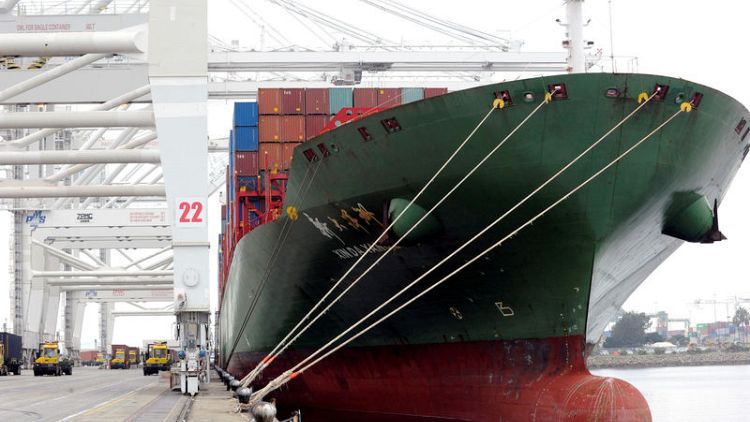By Lucia Mutikani
WASHINGTON (Reuters) - The U.S. trade deficit narrowed by the most in 10 months in January likely as China boosted purchases of soybeans, leading to a rebound in exports after three straight monthly declines.
The better-than-expected improvement in the trade deficit reported by the Commerce Department on Wednesday offered some good news for the economy after a raft of weak data, including retail sales, manufacturing and homebuilding, left economists anticipating a sharp slowdown in growth in the first quarter.
"At a minimum, the U.S. trade deficit softens some of the blow from all of the other negative figures," said Jennifer Lee, a senior economist at BMO Capital Markets in Toronto.
Still, the trade deficit remains large despite President Donald Trump's "America First" policies to significantly shrink it. The White House's protectionist trade tariffs have left the United States mired in a bruising trade war with China and provoked retaliatory tariffs from other trading partners.
The Commerce Department said the trade deficit declined 14.6 percent, the largest drop since March 2018, to $51.1 billion also as increased domestic oil production and lower crude prices curbed the import bill.
Data for December was revised slightly down to show the trade gap widening to $59.9 billion instead of the previously reported $59.8 billion. Economists polled by Reuters had forecast the trade gap narrowing to $57.0 billion in January.
Washington last year imposed tariffs on $250 billion worth of goods imported from China, with Beijing hitting back with duties on $110 billion worth of American products, including soybeans and other commodities.
Trump has delayed tariffs on $200 billion worth of Chinese imports as negotiations to resolve the eight-month trade war continue, with Beijing pledging to resume bulk purchases of soybeans after cancellations at the height of the trade fight.
U.S. Trade Representative Robert Lighthizer and Treasury Secretary Steven Mnuchin are in China this week for another round of talks with Chinese Vice Premier Liu He.
The politically sensitive trade deficit with China fell 6.4 percent to $34.5 billion in January.
U.S. financial markets were little moved by the data.
LOW GDP ESTIMATES
When adjusted for inflation, the goods trade deficit decreased $7.8 billion to $83.8 billion in January. The drop in the so-called real goods trade deficit could see economists bump up their very low first-quarter gross domestic product growth estimates.
The Atlanta Federal Reserve is forecasting GDP rising at a 1.3 percent annualised rate in the January-March quarter. The government reported last month that the economy grew at a 2.6 percent pace in the fourth quarter.
But that estimate is likely to be lowered when the government publishes a revision on Thursday as some economic data for December was weaker than had been previously assumed.
The trade deficit in January was pushed down by a 0.9 percent increase in exports to $207.3 billion. Soybean exports rose by $0.9 billion in January. Exports of motor vehicles and parts increased by $1.2 billion.
Export growth, however, continues to be constrained by slowing global demand and the dollar's strength last year, which is making U.S.-made goods less competitive on foreign markets. That is putting pressure on the current account.
In January, exports of capital goods decreased by $0.8 billion, led by a $1.3 billion decline in civilian aircraft shipments. Despite the rise in soybean shipments, exports to China were the smallest since September 2010.
Imports fell 2.6 percent to $258.5 billion in January, the lowest level since last June. Imports previously had surged, likely as businesses stocked up in anticipation of further duties on Chinese imports.
Capital goods imports dropped by $3.0 billion in January, led by a $0.9 billion decline in imports of computer accessories. There were also decreases in imports of semiconductors and civilian aircraft.
The weakness in capital goods imports likely suggests a slowdown in business spending on equipment. A drop in imports normally suggests cooling domestic demand. There were, however, increases in imports of consumer goods, as well as motor vehicles and parts in January.
Crude oil imports dropped by $1.4 billion, reflecting both lower volumes and prices. Imported oil prices averaged $42.59 per barrel in January, the cheapest since December 2016.
In second report on Wednesday, the Commerce Department said the current account deficit, which measures the flow of goods, services and investments into and out of the country, rose 6.1 percent to a 10-year high of $134.4 billion in the fourth quarter.
The current account gap represented 2.6 percent of gross domestic product in the fourth quarter, the largest share since the second quarter of 2012, up from 2.5 percent in the July-September period.
The deficit increased 8.8 percent in 2018 to $488.5 billion, the highest level since 2008. For all of 2018, the current account deficit averaged 2.4 percent of GDP, the biggest share since 2012, from 2.3 percent in 2017.
(Reporting By Lucia Mutikani; Editing by Andrea Ricci)



